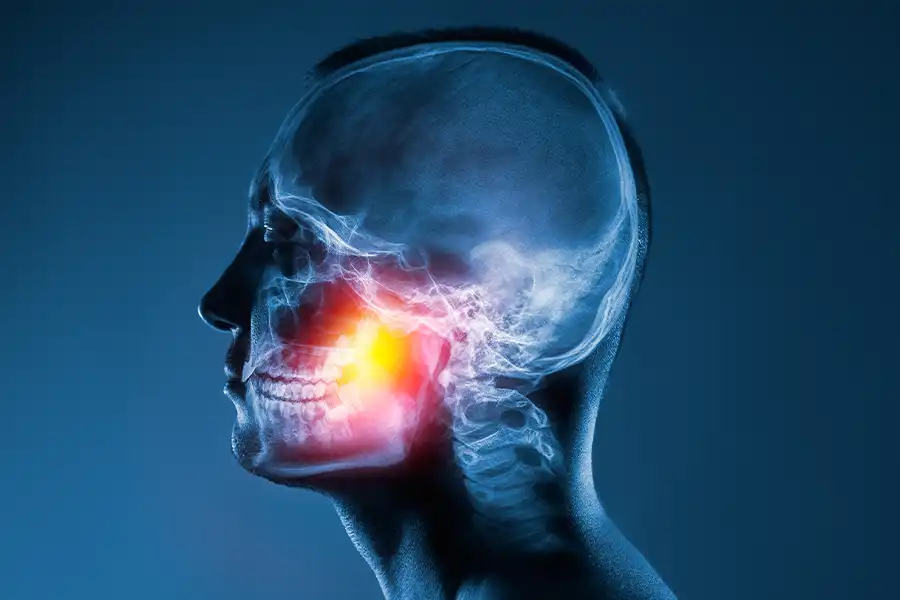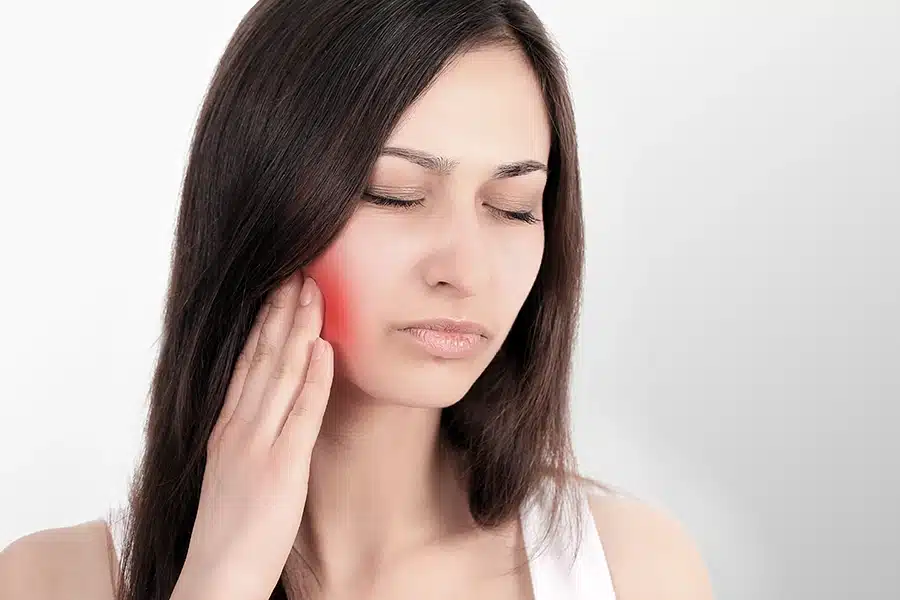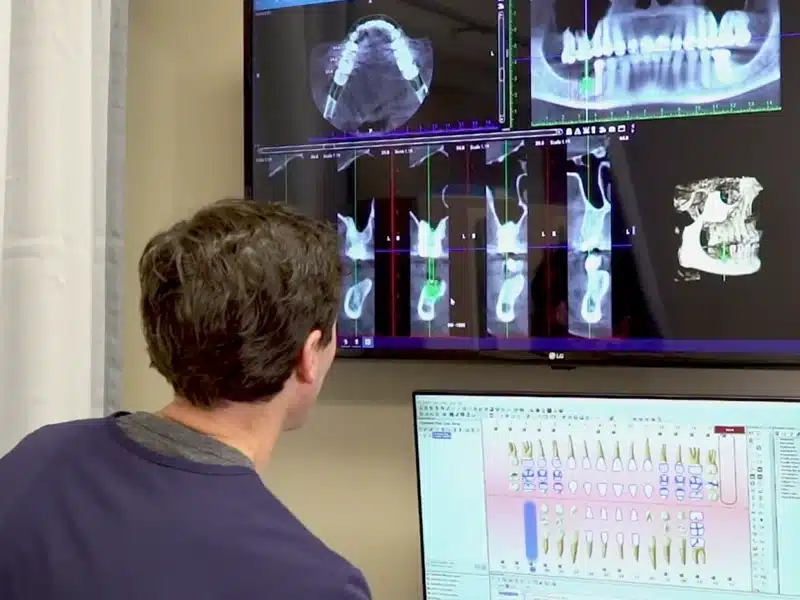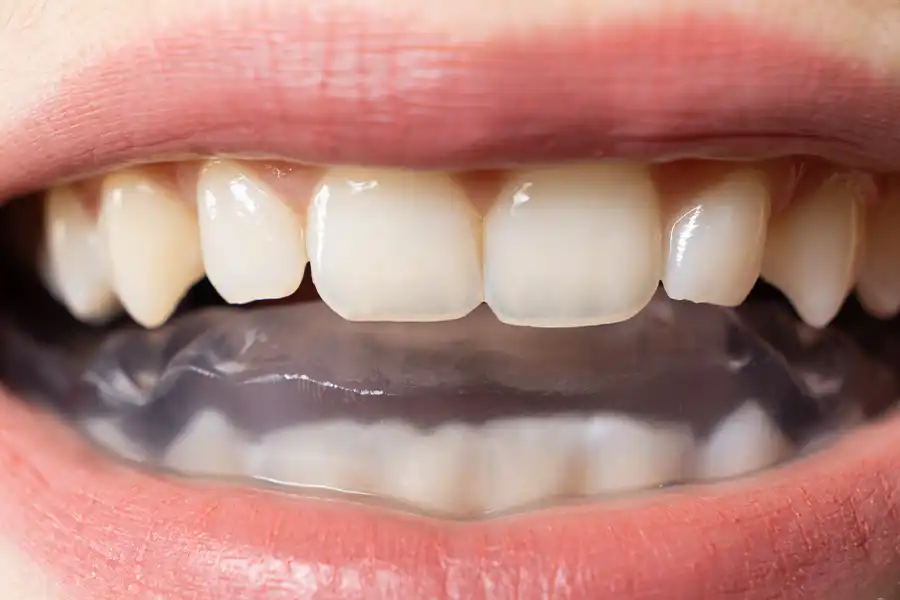Unlocking Relief: Your Guide to Managing Jaw Pain and TMJ Treatment

Struggling with TMJ pain and seeking effective treatment? You’re not alone. This article provides a straightforward guide to understanding and treating your TMJ problems. It will focus on practical solutions to help you feel better and have improved jaw function. These are things you can do today for relief! And these aren’t band-aids. Learn about immediate and long-term TMJ treatment options that get to the root cause of your problem.
Key Takeaways
- TMJ disorders, affecting jaw joint function, are common and can cause symptoms like jaw pain, limited mouth motion, and discomfort in and around the ear, potentially disrupting daily activities.
- The causes of TMJ pain are many, including genetic factors and stress-related behaviors like teeth grinding, which leads to the need for a comprehensive approach to diagnosis and treatment.
- Treatment of TMJ disorders always begins with a Cone Beam CT scan that shows the physical reasons for your symptoms. Once that is determined, we can move forward with non-invasive treatment options, including bite balancing, oral appliances and regenerative therapies.
Understanding TMJ Disorders

Conditions affecting the temporomandibular joints, also known as jaw joints, are referred to as TMJ disorders. These disorders include the two ball and socket joints that connect your jaw to your skull, and the intricate network of muscles and ligaments around them. When these joints work well, you hardly notice them, but when there are problems, they can cause a range of uncomfortable symptoms, including:
- Facial pain
- Jaw discomfort
- Limited mouth motions
- Jaw locking
Despite being surprisingly common, many people lack a clear understanding of these problems and how to find relief. To make matters more complex, the temporomandibular joint (TMJ) itself is a bit of a marvel of biological engineering, allowing for a wide range of motion that includes opening and closing the mouth and moving the jaw side to side. Disorders in this joint can cause ongoing discomfort that interferes with everyday activities like talking, eating, and even sleeping.
Identifying the Causes of TMJ Pain

TMJ pain isn’t straightforward; it arises from a variety of factors. Problems can arise from the way the jaw joints developed, blockages in your nose or airway or other structures in the head and neck, injury or perhaps even habits or stress-related behaviors like teeth grinding. Yes, that stress you’re carrying can manifest right in your jaw! It shows up as clenching and grinding, putting extra strain on your jaw joints and muscles, and making your TMJ pain worse.
Recognizing Symptoms of TMJ Disorders

The journey to relief starts with recognizing the symptoms. Are you experiencing pain or tenderness in your jaw? Maybe you’re hearing a painful clicking or grating when you move your mouth? Don’t overlook these signs. Even less common and more subtle signs such as buzzing, numbness, or ringing in the ears can be related.
Painful clicking or grating in the jaw joint when closing or opening the mouth is not normal. Its presence along with jaw pain may indicate a TMJ disorder. Additionally, less common symptoms such as:
- dizziness
- vertigo
- neck and shoulder discomfort
- facial pain
should not be ignored as they may be indicative of TMJ disorders.
Diagnosing TMJ Disorders: What to Expect

Suspecting a TMJ disorder? It’s time to seek help from a health-based dentist. This dentist should offer the following:
- A comprehensive review of your dental and medical history
- A Cone Beam CT Scan (CBCT)
- A detailed examination of your jaw
This process is best conducted by a health-based dentist who is knowledgeable about TMJ disorders and can provide initial care or make necessary referrals to specialists.
During the diagnostic process, the healthcare provider will:
- Ask about your symptoms
- Ask about any history of jaw injuries
- Ask about habits that may be relevant to the TMJ disorder
- Assess the alignment of your upper and lower teeth
And don’t worry, ruling out other conditions is a crucial part of this process to ensure you get a precise diagnosis necessary for an effective treatment plan.
Nonsurgical Treatments for TMJ Relief

The first step in diagnosis is determining if the symptoms stem from a muscle problem, a bone and joint problem, and a combination of both. The CBCT scan and the physical exam help determine which areas to treat. Once diagnosed, treatment usually begins with noninvasive methods. Remember, each of these treatments has its place and can often work best when used together. These treatments help manage pain and inflammation, providing relief for those affected.
There are three main types of nonsurgical treatments for TMJ relief: bite balancing to a muscle relaxed position, specially designed oral appliances that can create a space for healing in the joint, and stem cell therapy for regeneration. Each of these methods has its own benefits and can often be used in combination to provide a comprehensive approach to treatment and pain relief.
Muscle Treatment
If you have head and neck pain, headaches, get tired after chewing or talking or have trouble opening very far, you most likely have a problem with the muscles that surround the jaw joints. These muscle problems are often due to the way the teeth come together. Correcting these problems can make an enormous difference in your daily function.
Some therapies may involve balancing the bite on your teeth, repairing broken or worn down teeth, or moving teeth with orthodontic therapy. All of these therapies need to be completed in a muscle relaxed position. The jaws can be guided there with a combination of TENS therapy and skilled dental help.
These therapies can all lead to relief from many TMJ symptoms and will take anywhere from one appointment to multiple depending on the desired result.
Jaw Joint Treatment
If you have noises in the jaw joint, including painful popping or clicking or grating noises, if you struggle to open wide without discomfort, or if you feel your bite and teeth are changing or wearing down, you likely have jaw joint damage. This damage can be due to an earlier injury or even airway or other structural problems.
The first step to determining jaw joint problems is a Cone Beam CT scan (CBCT). This will help the health-based dentist see the exact condition of both joints and the supporting structures, which will guide treatment. This treatment may include a specially designed appliance to help hold the jaws slightly open. This appliance will allow the body to create scar tissue in the damaged area which will help the joint function better. This appliance needs to be made with a special recording device called a K7 scan. This treatment is followed by carefully fabricated tooth restorations or guided orthodontics.
Treatment may also be focused on the airway, and will often result in better sleep and improvement of fatigue and other symptoms. All of these treatments are specialized and should be performed by a health-based dentist.
Regenerative Treatments
The latest in regenerative medicine has also revolutionized TMJ treatment. Stem cells can be injected directly into the damaged joints to help reduce pain and inflammation and regenerate the damaged tissue. Ringing in the ears, dizziness, vertigo and more can be improved with these treatments. They are performed along with the physical changes and appliances listed above.
Choosing the Right Healthcare Provider for TMJ Treatment
Selecting a competent health-based dental provider is crucial. Look for someone with extensive experience in treating TMJ and craniofacial pain. Don’t hesitate to ask about their experience, credentials, and approach to treatment.
The ideal provider should possess the following qualifications:
- A minimum of two years of graduate study in TMJ and craniofacial pain
- Completion of 500 or more hours of continued education courses in TMJ and craniofacial pain
- Experience in treating over 100 TMJ or craniofacial pain patients
In assessing a potential healthcare provider’s aptitude for TMJ treatment, consider enquiring about:
- Their TMJ patient treatment experience
- Credentials and certifications of the provider and staff
- The diagnostic process and treatment necessity for TMJ
- Available treatment options with their risks and benefits
- The usual treatment duration and success rates
If you live locally click here to schedule a consultation with our practice. If you live outside the area, go to our online directory at Living Well with Dr. Michelle to find a dentist trained in these procedures.
Summary
This discussion on TMJ disorders has covered a wide range of topics, from understanding what TMJ disorders are and their causes, to recognizing their symptoms, diagnosing the condition, and exploring various treatment options. We’ve learned that TMJ disorders can be managed through a combination of muscle, jaw joint and regenerative treatments.
Our health is our most valuable asset, and understanding the nature of TMJ disorders can empower us to take appropriate measures to manage the condition and improve our quality of life. If you’re experiencing symptoms of TMJ disorders, don’t hesitate to reach out to a health-based dentist specialized in TMJ and craniofacial pain. The journey to relief starts with a single step.
Frequently Asked Questions
Can TMJ go away on its own?
For most people, discomfort from TMJ disorders will not go away on its own. If your jaw changes and joint noises decrease or stop, it is actually a sign of your condition worsening. It is important to seek treatment if you have pain and related symptoms.
Can TMJ be fixed?
Treatment for TMJ depends on the cause and severity of the damage in the joint. Just like a damaged knee that has lost cartilage, the joint can be repaired and returned to function.
Is TMJ a lifelong condition?
TMJ can be a lifelong condition for some people, with significant and long-term symptoms developing in some cases. If you are experiencing symptoms, it’s important to seek health-based dental advice for proper management.
How long does TMJ disorder last?
TMJ disorder can last from a few days to a few weeks, but in some cases it can persist for months or even years. It’s important to seek professional guidance for proper management.
What are TMJ disorders?
TMJ disorders are conditions that affect the temporomandibular joints and the muscles around them, causing discomfort and pain.

Dr. Michelle Jorgensen is an author, speaker, teacher, biologic/holistic dentist, and health and wellness, provider.
Dr. Michelle Jorgensen is also a Board Certified Traditional Naturopath and has received certifications as a Therapeutic Nutritional Counselor, and a Certified Nutritional Autoimmune Specialist. She completed a Holistic Dental Mini-Residency and is pursuing ongoing training from experts around the world in health-related fields.
Dr. Jorgensen also teaches and coaches groups of dental professionals across the country through her Living Well Professionals training. They learn how to integrate dentistry with other health disciplines to provide an integrated, whole body approach to care.



